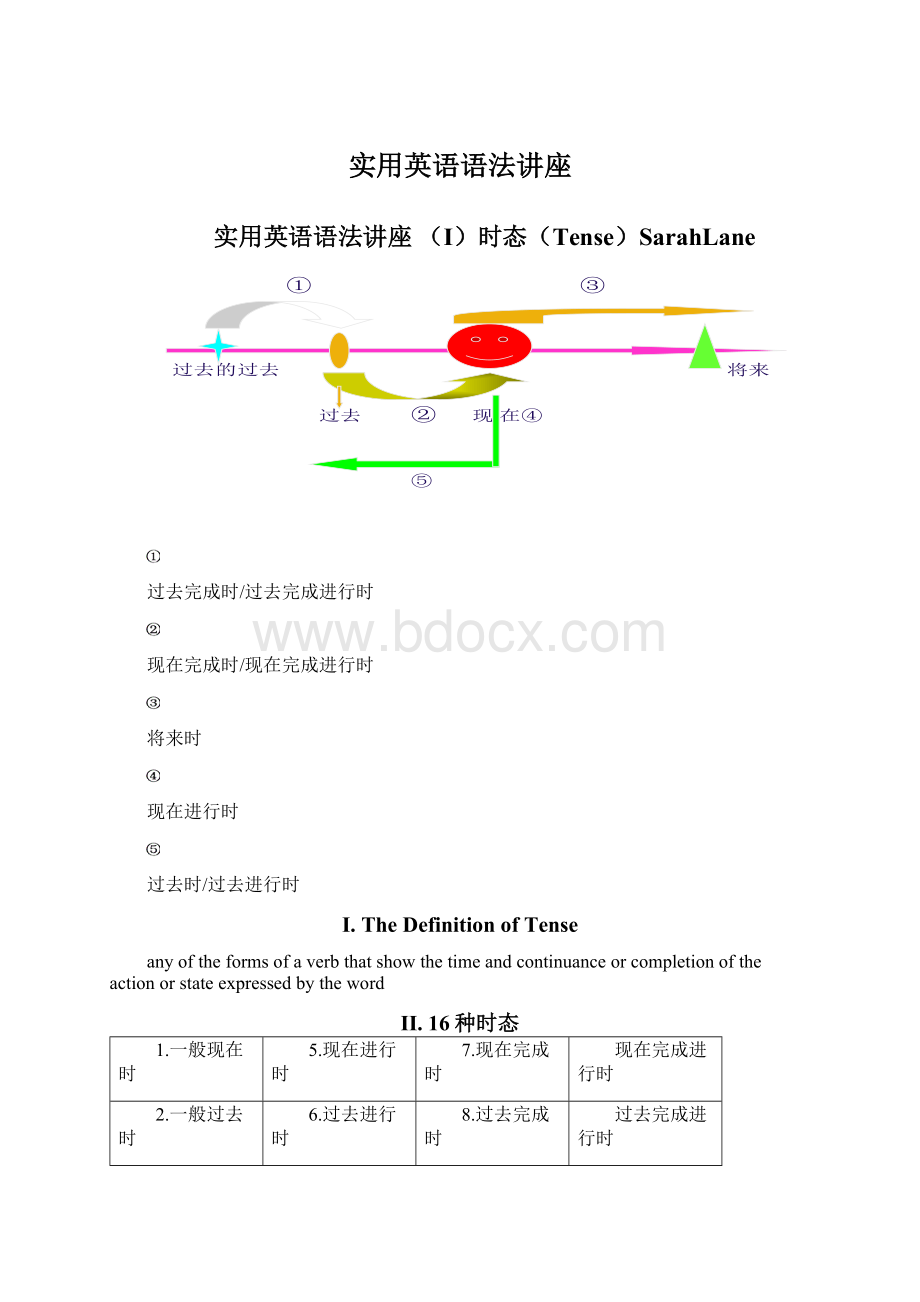实用英语语法讲座Word文件下载.docx
《实用英语语法讲座Word文件下载.docx》由会员分享,可在线阅读,更多相关《实用英语语法讲座Word文件下载.docx(20页珍藏版)》请在冰豆网上搜索。

助动词have+been+主要动词的现在分词。
IV.时态形式:
一般时态
进行时态
完成时态
完成进行时态
现在
write/writes
am/are/iswriting
has/havewritten
has/havebeenwriting
过去
wrote
was/werewriting
hadwritten
hadbeenwritten
将来
shall/willwrite
shall/willbewriting
shall/willhavewritten
过去将来
should/wouldwrite
.一般现在时(presenttense)
.构成:
✧由动词原形表示,但第三人称单数后+s,be/have有特殊的人称形式。
一般动词
动词tobe
动词tohave
Iknowit.
Iamastudent.
Ihaveabike.
Youknowit.
Youareastudent.
Youhaveabike.
He(She)knowsit.
He(She)isastudent.
He(She)hasabike.
We(You,They)knowit.
We(You,They)arestudents.
We(You,They)haveabike.
✧疑问式
Do/Does…+主要动词原形;
be动词只需与主语位置对调就行了。
e.g.Doyouknowit?
Issheastudent?
✧否定式
do(es)+not+主要动词(动词be则在后+not)
e.g.Youdonotknowit.
Sheisnotastudent.
.使用范围:
表习惯的,永久或反复发生的动作。
常与often,sometimes,always,twiceamonth,everyweek,
onSundays,occasionally,usually一些频度副词连用。
e.g.Birdsfly.(永久)
Shealwaystakesawalkintheevening.(习惯)
表特征,能力或状态:
e.g.Shelovesmusic.(特征)
Contradictionsexisteverywhere.(状态)
e.g.Weweretaughtatschoolthattheearth(is/was)round.(is)
表普遍真理,事实,也用在格言中:
e.g.Nomanbuterrs.
(人非圣贤,孰能无错。
)
表现在瞬间(常用于体育报道,戏法演说,技术表演等的解说):
e.g.Now,look,Iopenthebox.
Hesitsdown,shiversalittle.Clockoutsidestrikes12.(舞台说明)
表一个按规定,计划或安排发生的情况。
(这时都有一个表示未来的时间状语)
e.g.Theplanetakesoffat11a.m..
Thedelegationarrivesheretomorrow.
但这只限于少数的动词:
begin,come,go,leave,sail,start,arrive,return,dine,end,stop,open,close,be,etc.在时间和条件状语从句中,将来动作或状态多用一般现在时表示。
e.g.Tellheraboutthatwhenshecomes.
Wecancatchthebusifwehurryup.
有些状态和感觉的动词可用一般现在时:
be,love,like,hate,want,hope,feeletc.
e.g.Ifeelasharppaininmychest.
Thesoupcontainstoomuchsalt.
.一般过去式(pasttense)
✧一般是:
V.+ed;
be-was/were
✧疑问式:
did+V.原形(Was/Were提到句首)
✧否定式:
did+not+V.原形(was/were+not)
表示过去某个特定的时间或某一段时间发生的动作或情况。
(这种用法的过去时间可以是指明的,也可以是不指明的)。
e.g.TheforeignguestsvisitedNanjinglastyear.
Heneversmoked.
表过去的习惯动作。
e.g.WhenshewasinNanjing,sheoftenwenttotheCentralSupermarket.
.一般将来式(futuretense)
shall(第一人称)/will(第二、三人称)+V.原形
✧疑问式:
Shall/Will…+主要动词
✧否定式:
shall/will+not+主要动词
除U.K.以外说English的国家,在陈述句中,即使是第一人称一般也用will,在U.K.也有这种趋势。
口语为I’ll
表示将要发生的动作或存在的状态。
e.g.HewillgraduatefromKangdacollegenextyear.
表示反复发生的动作或惯性动作。
e.g.Thestudentswillhave6Englishclassesperweekthisterm.
本学期学生每周将要上6节英语课。
Springwillcomeagain.
.除了shall/will外,还有另外一些结构可表一般将来时。
begoing+不定式(表打算,准备做的事或即将发生或肯定要发生的事)。
e.g.We’regoingtoputupabuildinghere.
be+to(不定式)表示按计划,安排要发生的事或用来征求对方的意见。
e.g.AmItotakeoverthehiswork?
IthinkIamtofaint.(误)
IthinkIamgoingtofaint.(正)
如果不是人,人世所能安排或控制的动作一般就不能用beto这一结构表将要发生。
Thetalkisabouttobegin.(正)
Thetalkisabouttobeginsoon.(误)
beaboutto表示即将发生的动作,句中不可用未来时间的状语。
一般现在时可表示计划或时刻表要发生的事。
这一用法只限于某些动词:
be,come,go,begin,leave,sail,arrive,return,start,stop,end,open,stay,etc.
e.g.Theplaneleavesatsix.
Iamnotathometonight.
某些动词的现在进行时可以表示计划或安排要发生的事。
常用的有:
join,play,eat,work,return,take,wear,meet,move,sleep,have,do,stay,arrive,leave,speak,start,come,etc.
e.g.I’mmeetingJackatthestationatfourtomorrowafternoon.
我明天下午4点要去火车站接杰克。
(含有约好的含义)
Wearehavingameetingthismorning.
我们上午要开一个会。
(计划)
.一般过去将来时(pastfuturetense)
.构成:
should(第一人称)/would(其他人称)+V(在美国,甚至在英国,第一人称也常用would.)
表示从过去某时看来将要发生的动作或存在状态。
这个时态也是一个相对的时态,立足于过去某时,从过去的观点看来:
时间过去某时那时预见的情况现在
(用过去将来时)
e.g.Hewassixty-eight.Intwoyearshewouldbeseventy.
(他68岁了,再过两年就70了。
Hesaidthathewouldwaitforusatthebusstop.
goingtoV.(过去打算)
was/were+toV.(曾计划干什么,如计划的动作没实现,to后要用动词的完成时)
abouttoV.(过去即将发生的事)
e.g.Theyweregoingtohaveameeting.
他们曾经打算开个会。
Shesaidshewastohavetakenuptheposition,butlatershechangedhermind.
她曾经说过打算接受这份工作,但后来改变主意了。
Iwasabouttogooutwhenafrienddroppedin.
表示过去的某种习惯性行为,只用would,此时相当于usedto。
e.g.Wheneverwehadtrouble,hewouldcometohelpus.
.现在进行时(presentprogressivetense)
is/am/are+现在分词-V.ing
.使用范围:
表示现在进行的动作或发生的事。
e.g.ThestudentsarelisteningtothegrammarlectureintheA.V.Room.
表示现阶段正在进行的动作或发生的事。
e.g.SheislearningEnglishatcollege.
她目前在大学里学英语。
Myfatherisgenerallygoingtobedat11p.m.
表示某个最近的计划或安排将要进行的动作,或即将开始的或结束的动作。
常用的这类词有:
go,leave,come,arrive,land,meet,move,return,start,stay,stop,do,dine,give,have,pay,join,punish,spend,sleep,takeetc.
e.g.Heismeetingthemanagertomorrow.
Thesunissetting.(即将开始)
Heisdying.(即将结束)
现在进行时表将来有时还有表“决心”的意思。
e.g.Iamnotleavingtomorrow.
Iamtakingpartofit.
动作动词与always,forever,continually,constantlyetc.连用,表示重复的动作,这种动作可能使人感到厌倦或不合理。
e.g.Nothingcanpleasehim.Tomisalwayscomplaining.
Sheisalwaysreadingnovels。
(花的时间太多了)
care,mindetc.表示感觉,精神活动等的状态动词一般不用进行时。
e.g.Sheisresemblinghermother.(误)
resembles(正)
Iamknowingheiswrong.(误)
know(误)
※现在进行时与一般现在时得用法比较:
.暂时性动作和经常性动作:
e.g.Forthisweekwearestartingworkat7:
30.(临时安排)
Westartworkat7:
30.(经常性)
.持续性动作和短暂性动作:
e.g.Thebusisstopping.(渐渐地停下来)
Thebusstops.(迅速停车)
.暂时性动作和永久性动作:
e.g.SheislivinginGuangzhou.(短时间居住)
ShelivesinGuangzhou.(永久性)
.带有感情色彩和不带感情色彩:
e.g.Janeisdoingfineworkatcollege.(赞扬)
Janedoesfinewokatcollege.(事实)
.过去进行时(pastprogressivetense)
.构成:
was/were+现在分词V.ing
表示过去某一时刻或某阶段发生的动作。
e.g.Wewereexpectingyouyesterday.(贯穿整个昨天)
Weweretalkingaboutyourbookthismorning.Thebookisreallygreat.(用来打开话题)
不与时间状语连用可以表示逐渐的变化或发展。
e.g.Thewindwasrising.(起风了。
Itwasgettingdark.(天渐渐暗下来。
在条件或时间状语从句中表示过去将来正在进行的动作。
e.g.Shetoldmetowakehimupifhewassleeping.
表示按计划安排过去将要发生的动作。
e.g.TheywereleavingforNewYorkforafewdayslater.(他们曾打算晚几天去纽约。
Shewasdepartingthenextmonth.
与forever,always,continually,constantlyetc.连用,带有某种感情色彩。
e.g.Shewasalwayschanginghermind.(不满)
Mymotherwasconstantlypraisingher.(赞扬)
表示最近过去的事。
e.g.IwashearingJanehadenteredthecollege.
Janewastellingmeaboutitthismorning.
表示过去未实现的愿望或打算。
e.g.Shewascoming.
她本来要来的。
(Shedidnotcomeactually.)
Iwasseeinghertomorrow.
我本来明天要见她的。
※与一般过去时的区别
过去进行时
过去时
1).表示反复的动作
e.g.Shewaswavingherhand.(她不停的挥手。
1).表示只做一次的动作
e.g.Shewavedherhand.(她挥了挥手。
1)2).leave,arrive,start,dieetc.
2)在过去进行时表示“快要完成,即将”
e.g.Thetrainwasstopping.(火车渐渐地停了。
2)leave,arrive,start,dieetc.
在过去时表示“已经完成”
e.g.Thetrainstopped.(火车停了。
.现在完成时(presentperfecttense)
人称形式+过去分词
肯定式
否定式
疑问式
I(We,They)havetakenit.
I(We,They)havenottakenit.
Haveyou(they,we)takenit?
He(She)hastakenit.
He(She)hasnottakenit.
Hashe(she)takenit?
表示过去所发生的动作或事情对现在的影响或产生的结果,着眼点在现在
现在完成时常与不确定的过去时间状语连用:
yet,just,recently,once,latelyetc;
也同表示频度的时间状语连用:
often,ever,never,sometimes,twice,onseveraloccasionsetc;
也同包括现在时间在内的时间状语连用:
now,today,thismorning,thismonth,thisyearetc.
☆但不能同特定的过去时间状语连用,in2000,lastyear,manyyearsago
e.g.Shehaslostherwallet.(现在没钱花了)
Hehaslaidthetable.(已可吃饭)
Haveyoueaten?
(现在你饿不饿?
Ithassnowedhereeverydaysincelastyear.
☆everyday是副词短语,即可同一般现在时连用,表示“每天”,也可同现在完成时连用,指从过去某时到现在一段时间的“每一天”。
表示一个从过去某个时间开始,延续到现在,并可延续下去的动作。
常同一段时间的状语连用:
sofar,uptonow,since,foralongtime,uptillnow,uptopresent,forthepastfewyears,thesefewdays(weeks,months,years)
e.g.Hehasworkedhereforovertwentyyears.
Uptonow,wehavereceivednonewsfromher.
Harryhasgotmarriedforsixyear.
Harrygotmarriedsixyearsago.
Harryhasbeenmarriedforsixyears.
某些非延续性动词(动作一开始就结束的动词),在现在完成时中,不能同表示一段时间的状语连用常见这类词有:
come,go,begin,start,become,arrive,get,reach,leave,join,end,die,find,lose,fall,jump,knocketc.
ThisisthefirsttimethatI(hear)hersing.(haveheard)
“It(This)is(willbe)thefirst(last…)timethat…”结构中的从句要求用现在完成时
e.g.Itisthesecondtimethatwe’vemeteachother.
ItisthebestfilmI.(see)(haveseen)
“It(This)isthebest(worst,mostinteresting)+n.+(that)…”结构中的从句要求用现在完成时
e.g.ThisisthemostinterestingnovelthatIhaveeverwritten.
※几组时态比较
e.g.
1)ShehasgonetoBeijing.
她到北京去了。
(现在不在这里)
ShehaseverbeentoBeijing.
她曾经去过北京。
(现已返回)
2)Thedoorhasbeenclosed.
门已经被关上了(动作)
Thedoorisclosed.
门是关着的。
(状态)
3)IhaveseenherthisMay.
(讲话时还在五月)
IsawherthisMay.
(讲话时五月已经过去)
4)ShecomesfromNanjing.
她是南京人。
(出生于南京)
ShehascomefromNanjing.
她从南京来。
(不一定是南京人)
※现在完成时和一般过去时几组句子的差异:
e.g.
1)Haveyoufinished?
(如你已经讲完,我想接着讲。
Didyoufinish?
(不知我刚才发言时你是否讲完话了。
2)WhatIhavedonetomakehimsoangry?
(认真提出问题,而且对方仍在生气。
WhatdidIdotomakehimsoangry?
(过去生气,现在则不一定。
)
3)ShehaslivedinBeijingfortwentyyears.
(她仍活着,住在北京。
ShelivedinBeijingfortwentyyears.
(她已逝去。
.过去完成时(pastperfecttense)
had+过去分词
.使用范围:
表示过去某个动作或某个具体时间之前已经发生、完成的动作或情况。
e.g.TheyhadgoteverythingreadybeforeIcame.
Bytheendoflastweekshehadwrittentwopapers.
过去完成时常用在有hardly/sca